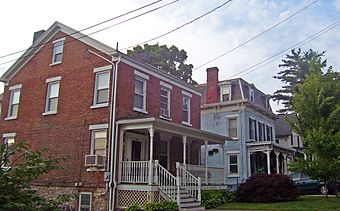Stone Street Historic District (New Hamburg, New York) facts for kids
Quick facts for kids |
|
|
Stone Street Historic District
|
|

5,7 and 9 Stone Street, 2008
|
|
| Location | New Hamburg, NY |
|---|---|
| Nearest city | Poughkeepsie |
| Area | 1 acre (4,000 m²) |
| Built | mid-19th century |
| Architectural style | Greek Revival, Second Empire |
| MPS | New Hamburg MRA |
| NRHP reference No. | 87000120 |
| Added to NRHP | 1987 |
The Stone Street Historic District is a special area in New Hamburg, New York. It's a small part of Stone Street that has a group of old houses. These houses were built in the middle of the 1800s.
This area was added to the National Register of Historic Places in 1987. This means it's an important place that needs to be protected. It has some of the best-preserved old homes in New Hamburg. The houses show different building styles from that time, like Greek Revival and Second Empire. They sit on a small hill with nice views of the Hudson River.
Cool Houses on Stone Street
The Stone Street Historic District includes four main houses. They are all on the west side of Stone Street, between Bridge Street and Division Street. The house at 18 Division Street is also part of this special group. All these buildings are important to the district's history. There are also two smaller buildings, like a barn, that are part of the history too.
- 5 Stone Street: This house was built around 1858. It has two stories and is made of brick. It has a porch that runs along the front. The front door has cool glass panels on the sides and above it.
- 7 Stone Street: Built in 1870, this house is in the Second Empire style. It's similar in size to number 5. It has a special roof called a mansard roof with slate tiles. It also has small windows sticking out of the roof, called dormer windows. There's a small barn behind it that's also historic.
- 9 Stone Street: This house was built around 1870. It has one and a half stories and a unique L-shaped roof made of slate tiles. It has a front porch with decorative brackets.
- 18 Division Street: This house was first built in 1845. It was updated a lot in 1870. It's a two-story house with wooden siding. It also has decorative brackets under the roof edges.
A Look Back in Time
The land for these houses originally belonged to Samuel and Maria Ellis. They bought it in 1841 and built the first house at 18 Division Street. After Samuel died in 1857, Maria and her children started selling the other pieces of land.
At this time, the Hudson River Railroad had just been built nearby. This made Stone Street a great place to live. It was on a small hill and close to the downtown area.
Marvin Van Anders, who owned a hotel, built 5 Stone Street for himself in 1857. The land next door was sold to Peter and Rachel Leroy, who built 7 Stone Street and lived there for 20 years. In 1870, William Bogardus, who worked for the railroad, bought 9 Stone Street. The house at 18 Division Street was also updated a lot that same year.
Around 1900, the area changed. The New York Central decided to make their train tunnel into an open cut. To do this, they bought and tore down the houses on the east side of Stone Street. This opened up the view for the houses on the west side.
The neighborhood changed again in 1928. The railroad expanded to four tracks and closed the main street crossing. A new street, Bridge Street, was built. This made the Stone Street area easier to get to from the center of town.
Over the years, some of the houses have been turned into apartments. New Hamburg is no longer a big shipping center. Now, Metro-North trains use the tracks for people traveling to work. Even with these changes, Stone Street has stayed mostly the same.
Building Styles
The houses at 5 and 7 Stone Street show interesting differences in how they were built. Number 5, with its Greek Revival style, was built in a way that was already a bit old-fashioned for its time. It's like they chose a classic look.
But number 7, in the Second Empire style, was very modern for a small town back then. Maybe Peter Leroy, who was a riverboat captain, saw new building styles in other towns he visited and wanted his house to be up-to-date.
A cool thing that connects all four houses is their porches. They have a style called "Hudson River Bracketed." This also shows that the builders knew about popular architecture trends beyond just New Hamburg.
Someone once said that houses 5 and 7 used to have the same roof. But a fire at number 5 made them rebuild its roof in a more common style.

